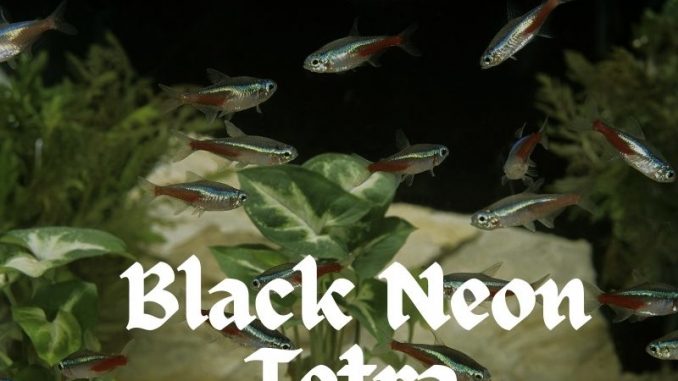
The black neon tetra is a small, freshwater fish that is part of the Characidae family.
This fish, along with many other types of tetra fish, is popular among aquarists due to its energetic personality and peaceful temperament.
Black neon tetras are a great fish for beginner fish keepers due to the fish’s pleasant nature and simple dietary needs. Black neon tetras are a beautiful addition to any aquarium, but larger fish may pose a threat to this small species.
TABLE OF CONTENTS
Black Neon Tetra Facts & Overview

| Category | Rating |
| Care Level: | Easy |
| Temperament: | Peaceful |
| Color: | Iridescent white, green, or black |
| Lifespan: | ~5 years |
| Size: | Up to 1.6 inches |
| Diet: | Omnivore |
| Family: | Characidae |
| Minimum Tank Size: | 10 gallons |
| Tank Set-Up: | Freshwater, dim lighting with plants |
| Compatibility: | Peaceful, shoaling species |
The black neon tetra (Hyphessobrycon herbertaxelrodi) is a small fish that originates from the tropical freshwater of southern Brazil.
The “Hyphessobrycon” part of its scientific name signifies that it is of the Hyphessobrycon genus, which is a genus of freshwater fish in the family Characidae.
The second part of the scientific name, “herbertaxelrodi”, joins the first and last names of tropical fish expert Herbert Axelrod, who wrote a description of black neon tetras in his magazine on tropical fish.
Black neon tetras are native to the Paraguay Basin of southern Brazil. In their natural habitat, these fish prefer flooded forest areas, small creeks, and sandbanks. Black neon tetras usually inhabit acidic water that is stained brown by decaying plant matter.
Black neon tetras are common and popular among aquarists. They live for around five years in captivity.
Black neon tetras are very easy to find in pet stores. These fish are inexpensive and usually cost from $2–$4 each.
Appearance & Behavior
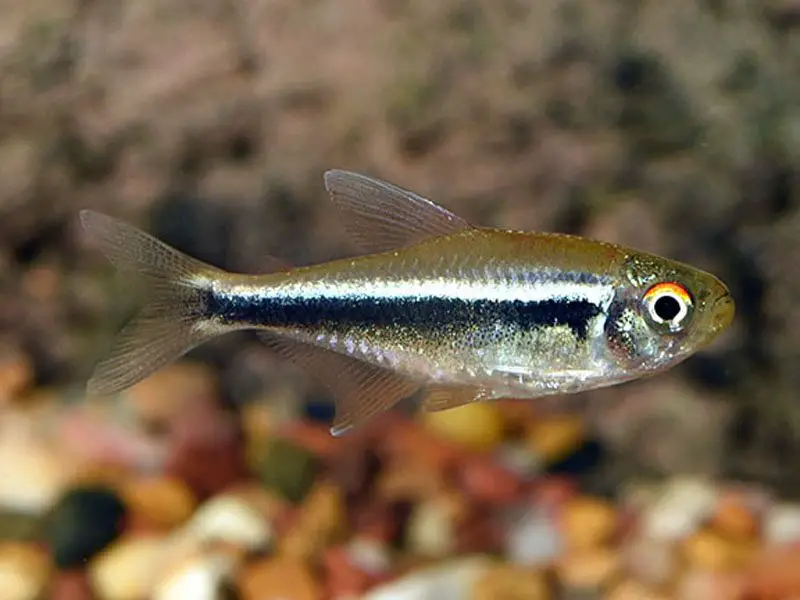
Black neon tetras are beautiful fish and come in a variety of colors.
They have dark bodies with a primarily greenish hue. On top of this base color, black neon tetras have two distinctive stripes that travel the length of their bodies.
The first stripe is a thin, white, iridescent band that sparkles under the light. Under the white band is a thicker black band that gives the black neon tetra its name.
The tops of the fish’s eyes are ringed with a bright orange color that gives black neon tetras a splash of color and contrasts with their darker bodies.
It can be difficult to tell male and female black neon tetras apart. Females grow slightly longer than males and have more rounded bellies, but these characteristics may be hard to notice due to the small size of this species.
When females are pregnant, their stomachs become more pronounced, making it very easy to distinguish between males and females.
Black neon tetras can become stressed if they are lonely, in the presence of a predator, are constantly exposed to bright light, or are in unsuitable water conditions. When stressed, the black neon tetra’s colors start fading.
Black neon tetras are small fish that usually only grow up to 1.6 inches long.
Typical Behavior
Black neon tetras are a peaceful species that get along well with other fish. They never exhibit aggressive behavior and have a very gentle nature.
These fish prefer to swim out in the open in the middle and top of the tank. Black neon tetras are energetic and dart around quickly when swimming.
They are active in the day, during which they swim and eat, and sleep during the night.
Black neon tetras sleep huddled at the bottom of the tank. Their color fades slightly while they sleep, but returns when they wake up.
Black neon tetras are skilled jumpers and may try to demonstrate their skills if given the chance. Keep the top of your tank covered to ensure they don’t jump out of it.
Black Neon Tetra Care
Black neon tetras are a joy to keep and are easy to care for due to their hardy nature and peaceful temperament.
They prefer living in acidic water that imitates their natural habitat in the freshwater of southern Brazil. Adding plants to your tanks will make black neon tetras feel more at home and give them foliage to swim through.
These fish aren’t picky eaters and eat a variety of foods. Flakes, frozen food, small live worms, and brine shrimps, and freeze-dried foods are all suitable for the omnivorous black neon tetra.
The black neon tetra is susceptible to all the illnesses that affect other tropical fish, such as ich and dropsy. These ailments are best prevented by ensuring your black neon tetras are swimming in clean water. Replacing 30%–50% of the water in your tank every other week will keep your fish healthy and happy.
Disease
Diseases in black neon tetras are most often brought on by unsatisfactory water conditions and infected fish. You can prevent most fish diseases by adhering to the preferred water parameters of black neon tetras, keeping their tank clean, and quarantining new fish for 4–6 weeks before adding them to the main tank.
Ich
One disease that may affect these fish is ich, which is one of the most common diseases encountered in tropical fish aquariums. Symptoms include small white dots on the body and gills of the fish, loss of appetite, and abnormal hiding behavior.
Ich is caused by a parasite, Ichthyophthirius multifiliis, whose complex life cycle makes this disease hard to treat. Quarantine any infected fish for a few weeks and treat them with over-the-counter ich medicine. Cycle your water to ensure you eliminate any last instances of the parasite in the tank.
Dropsy
Another disease that may affect black neon tetras is dropsy. Symptoms include swelling of the stomach, lethargy, loss of appetite, and an abnormal habit of floating around the top of the tank.
To treat dropsy, quarantine any affected fish and create a salt bath by adding 2.5 teaspoons of Epsom salt for every ten gallons of water in the tank. This will draw out the excess water in the fish’s body that caused it to swell.
Feed your fish over-the-counter antibacterial fish food and monitor their progress for around a week. If no improvement is seen during this period, treat your aquarium water with Maracyn Two to fight the bacteria that cause dropsy.
Neon Tetra Disease
Black neon tetras may also be affected with neon tetra disease. This disease was first found in neon tetras and affects fish with a parasite that eats the muscles from the inside out once it reaches the intestinal tract.
Symptoms include abnormal individuality in schooling fish, cysts, difficulty in swimming, and curving of the spine. There is no cure for neon tetra disease, so the only thing you can do is try to prevent it from spreading to your other fish.
Remove any affected fish from the tank as you will not be able to keep them anymore. After the initial outbreak, maintain high-quality water levels with regular cleanings.
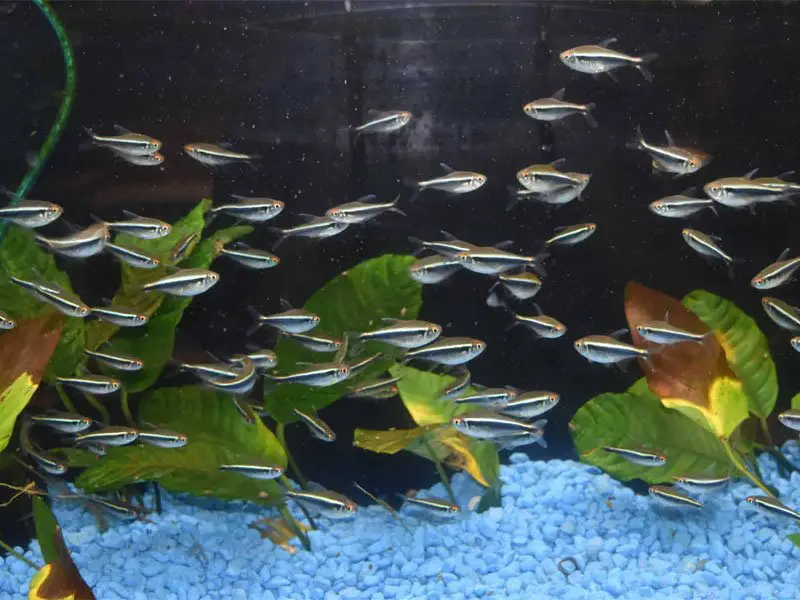
Habitat and Tank Requirements
In the wild, these fish inhabit creeks, rivers, and flooded forest areas, meaning their natural habitat has plenty of plants and shade.
The water that black neon tetras live in also contains decaying plant matter, which releases tannin into the water. Tannin makes the water acidic and also darkens it.
The river beds in the black neon tetra’s natural habitat are made up of dark river sand and are covered with small rocks and pebbles.
Overall, black neon tetras inhabit water darkened by shade, tannin, and a dark substrate. Their ideal water condition is warm, acidic water filled with plants and driftwood.
Imitating these conditions will provide your black neon tetras with a comfortable habitat.
Tank Conditions
Knowing how to set up your fish tank to replicate the natural habitat of your black neon tetra will keep them healthy and stress-free.
Black neon tetras are freshwater fish that are native to the warm waters of South America. Their preferred water conditions can be mimicked with a water temperature of 72°-77° F.
To ensure your black neon tetras don’t suffer from loneliness, keep at least six of them together.
The maximum number of fish in a tank should be equal to the tank’s capacity in gallons divided by the length of the fish in inches. Black neon tetras are small and reach lengths of up to 1.6 inches when fully grown, so we recommend at least a 10-gallon tank.
Black neon tetras are energetic shoaling fish, which means they need space to swim around as a school. These fish should be kept in a tank at least 20 inches long, 10 inches wide, and 10 inches high to allow them to swim around comfortably.
Use a dark substrate covered with small pebbles to darken the water and mimic the river beds found in the black neon tetra’s habitat.
Replicate the black neon tetra’s heavily planted underwater environment by placing plants and decaying plant matter in your tank. The decaying plant matter will release tannin into the water, lowering its pH level and darkening it. Staining your water brown with tannin will also bring out the color of your black neon tetras, making them stand out.
Black neon tetras live in water with a lot of tannin in it, making it acidic. To ensure your fish are comfortable, keep their water at an acidity of 5.5–7 pH.
These fish don’t produce a lot of waste, so a sponge filter will be enough to keep their water clean. Replace 30%–50% of the water in the fish tank every other week to prevent illnesses and keep your black neon tetras healthy.
Tank Mates
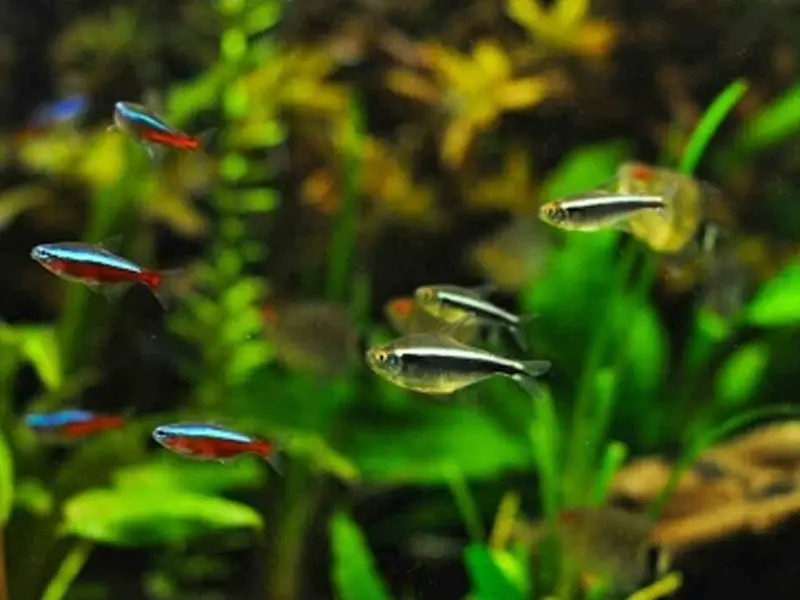
Black neon tetras have a peaceful temperament and get along well with other fish.
Don’t keep black neon tetras in the same tank as fish that are aggressive or too large. Even if a fish is peaceful, if its mouth is large enough to swallow a black neon tetra, these two fish should not be kept in the same tank.
Black neon tetras are compatible with any other small, peaceful fish, including:
- Barbs
- Danios
- Gouramis (avoid larger species)
- Rasboras
- Small catfish (such as corys)
- Other tetras (such as neon tetras or rummy nose tetras)
Black neon tetras are also compatible with snails. Due to their pleasant nature, these fish won’t prey on snails as long as the tetras are well-fed.
Diet and Feeding
Black neon tetras are omnivores, meaning their diet consists of meat as well as plant matter. In their natural habitat, these fish eat crustaceans, small invertebrates, insect larvae, fallen fruits, and algae.
To keep these fish happy and bring out their best colors, feed them a varied, omnivorous diet. Black neon tetras aren’t picky eaters and can be fed frozen, freeze-dried, flake, and live food.
The majority of the black neon tetra’s diet should be made up of a high-quality flake or pellet. You can feed it live or frozen food to supplement their diet, including:
- Blood worms
- Brine shrimp
- Daphnia
- Mosquito larvae
- Tubifex
Black neon tetras are small fish and may not be able to swallow whole worms or shrimp. Cut live food into very small pieces to ensure they will be able to eat it.
Feed your black neon tetras twice a day for three minutes when they are young adults. As they mature, feed them once a day for three minutes.
Breeding
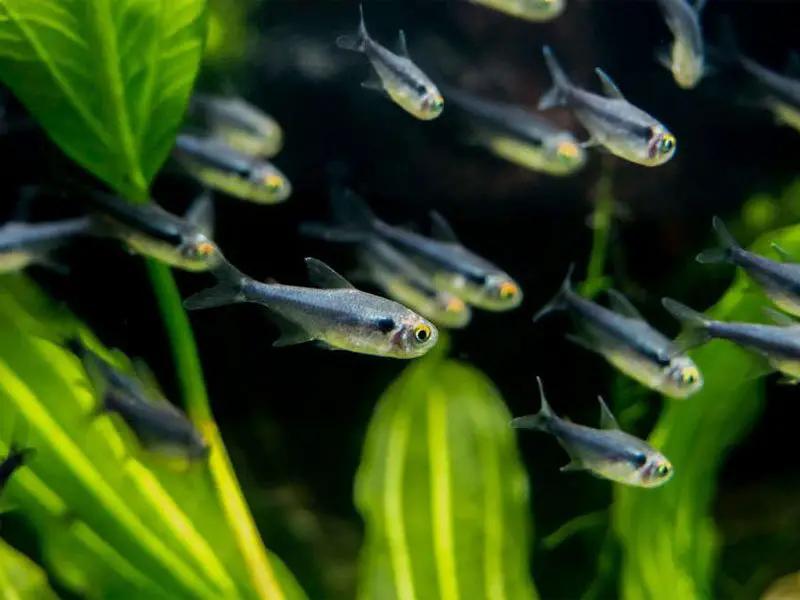
Black neon tetras are egg layers and aren’t difficult to breed. Select your healthiest fully mature fish for breeding as they will produce the best results. You should look for your brightest and fastest black neon tetras that are at least a year old.
Select one or two males and place them in a separate breeding tank with several females. Your breeding tank should be very dim. Use a dark substrate and cover your tank walls with cardboard if your room is very bright.
Filter the water with peat to encourage your black neon tetras to spawn. Add fine-textured, live plants to dim the tank and provide the females with an area to spawn. A layer of mesh can also work, but make sure the holes are big enough to let eggs pass through but small enough to keep the breeding group out.
Condition your breeding group by feeding them live foods such as mosquito larvae and brine shrimp. While conditioning your breeding group, set the water temperature at 75° F, and maintain soft water with a hardness of 2–4 dGH and an acidity of 6 PH. After a few days, gradually raise the water temperature to 80° F to trigger spawning.
When spawning occurs, females will scatter hundreds of eggs onto the plants and substrate. This generally happens in the early morning. Remove the breeders after spawning, as captive black neon tetras tend to eat their eggs and fry.
The eggs will hatch in around 22–26 hours. After they hatch, wait for three or four days while the fish fry eats their egg sacs and grows larger. You can then start feeding them infusoria, newly hatched brine shrimp, crushed flakes, or commercial fry food.
After a month, try feeding the fry adult food broken into smaller pieces. If they reject it, keep on feeding them with their original diet until they are large enough to eat adult food.
You can place the fish fry in your main tank when they are large enough that they aren’t in danger of being eaten.
Should You Get a Black Neon Tetra for Your Aquarium?
Black neon tetras are compatible with all other small, peaceful fish. This species is very popular among aquarists due to its beautiful color and energetic nature.
Black neon tetras will be a great addition to any tank, as long as you aren’t planning on keeping them with large or aggressive fish that might try to prey on them. If you are looking for some energetic, eye-catching, and easy-to-care-for freshwater fish to brighten up your tank, black neon tetras are the fish for you.


Be the first to comment